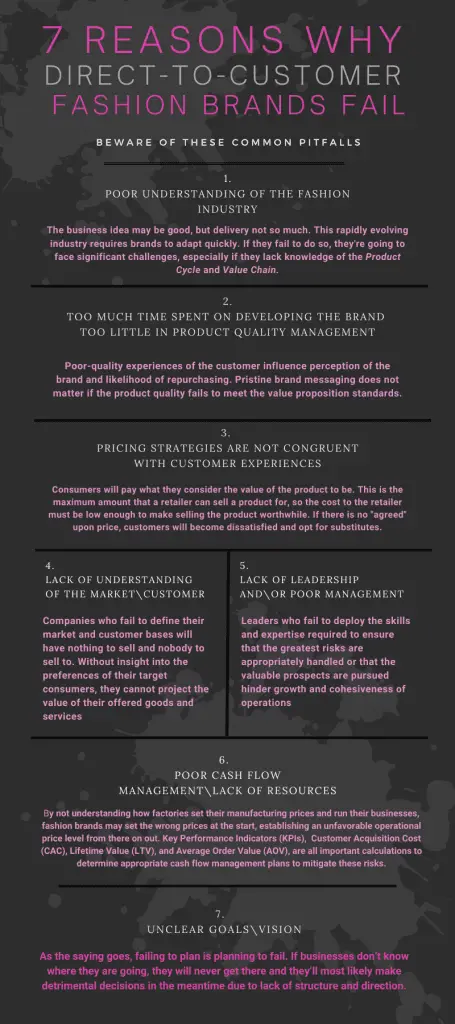Introduction
It is no doubt direct-to-customer fashion brands are on the rise. These models are increasingly becoming more popular as brands are looking to acquire end-to-end control over the production, marketing, and distribution of products. Simply, they hop over wholesale and use an infrastructure that allows them to grow fast and connect immediately with their customers. If they’re prepared. In this new age of digital technology and shift towards online platforms, many fashion entrepreneurs are diving in, but few are experiencing success due to unforeseen challenges.
The method of selling directly to – and reconnecting with – customers is a complex one, as demonstrated by multiple failures and somewhat-successes. As retailers are contending with this inevitable digital transformation, many of these failures highlight the difficulty of building their own brand presence online and attracting customers. In this post, we’re going to examine the top 7 reasons why direct-to-consumer fashion brands fail.
- Poor Understanding of The Fashion Industry
- Too Much Time Spent on Developing The Brand, Too Little In Product Quality Management
- Pricing Strategies Are Not Congruent with Customer Experiences
- Lack of Understanding of The MarketCustomer
- Lack of Leadership AndOr Poor Management
- Poor Cash Flow ManagementLack of Resources
- Unclear GoalsVision
- Conclusions
1. Poor Understanding of The Fashion Industry
Like any industry, there are different business models for different niches. In the fashion industry, it is especially important to develop a brand with a model and plan that are suitable for the niche or it will not favour well.
For many DTC fashion brands, the business idea may be good, but the delivery not so much. If brands cannot adapt to their environment, they will fail shortly after launch due to the ever-evolving nature of the industry. It is evident that fashion relies on production cycles that have become increasingly short over time, with the fastest companies replacing collections in stores every 6 weeks. When you think about how much planning, design, and effort goes into creating a collection, that ability for businesses to crank those out in under two months is astounding.
If brands do not have a firm grasp on the inner workings of the supply chain and Product Life Cycle in this industry, it is very hard for them to adapt on a dime. Many have a hard time when attempting to gain a competitive advantage in all four areas of the Value Chain: Research and Development, Production, Marketing, and Distribution/Sales due to the costly investment.
If brands aren’t prepared to take these straight on, it’s likely they’ll have a good chance of going under too.
For more educational content in the Fashion Business Industry, visit our other posts out now!
How to Write a Business Plan for Your Fashion Brand
Identifying Business Models in the Fashion Industry
2. Too Much Time Spent on Developing the Brand, Too Little in Product Quality Management
Product quality management is managing the company’s ability to satisfy customer’s needs and expectations through four main methods:
- Quality Planning: Devises how to satisfy the process and deliverable products quality requirements
- Quality Control: Measures the quality level of products
- Quality Assurance: Ensures that right things are being done in the right way
- Quality Improvement: Analyses practice performance and efforts for the improvement of the performance.
Consumers evaluate the quality of products all of the time. While they might not be aware that they are constantly engaged in a product evaluation process, they still certainly notice when their clothes do not fit right or materials start falling apart.
The problem is poor-quality experiences influence perception of the brand and likelihood of endorsing or purchasing from that brand again. It does not matter how pristine the imaging and messaging are if the product quality fails to match the value proposition. Consistent defects in product or service quality will inevitably lead to a decline in business.
3. Pricing Strategies Are Not Congruent with Customer Experiences
Consumers are willing to pay what they consider the value of the product to be. This is the maximum amount that a retailer can sell a product for, so the cost to the retailer must be low enough to make selling the product worthwhile.
Let’s dive into some of the common pricing strategies and assess how each one could stray from consumer expectations.
- Cost-based Pricing: With cost-based pricing, the manager simply adds a percentage on top of the cost of production of a product to ensure it is profitable. A downside to this pricing strategy is that it does not force a business to keep its costs under control – rather, costs are simply diverted through to the customer.
- Value-based Pricing: Cost-based pricing is the opposite of value-based pricing. Here, the concern is how effective the value proposition is to their target segmentation. How are consumers perceiving the value that will come with your product? With Value-based pricing, you can charge higher than your competitors. The pricing strategy helps to frequently improve products and foster long-lasting customer relationships.
- Dynamic Pricing: This approach uses algorithms to assess the optimal price point by weighing the data on supply and demand, the pricing points competition are using, and all other related market factors applicable to the product line. This method often brings the highest profit margins for products where inconsistent pricing is not a problem. Quality analytics and data mining are great for making accurate pricing predictions. The goal of this approach is to strengthen customer relationships by offering the most value at every step of the way. Interested in learning more about how data science is influencing the fashion industry? Read more here.
It doesn’t matter if a product’s price is optimal for maximizing revenue if it is not relevant to understanding the trigger features and value propositions of the customer. Way too many companies advertise an identical message to everyone. Even if they’re selling to a niche, perceived value will be different amongst different qualities, age, sex, and geographical locations and this is something to consider.
Consumers are smarter than ever and well-conditioned to recognize what excellent service is. They know what good service is because the best companies have taught them. As a result, they have been refined to be firm on what they expect when purchasing. This is why it is so important to conduct in-depth market and customer segmentation. If the customer feels they are not receiving their perceived value from a product or service compared to others in the market, what is the probability they will purchase again? Ensuring product or service’s value meets the pricing strategy will keep consumers happy and ready to buy from the brand again.
To read more about segmenting your market to meet consumer expectations, check out this post of ours: Market Segmentation in the Fashion Industry.
4. Lack of Understanding of The MarketCustomer
As mentioned above, the fashion industry is constantly evolving to accommodate consumers’ change in taste. With the changing demands and trends, DTC fashion brands need to concentrate on differentiating their products and services in a way that valuably addresses the needs and demands of customers.
Companies who fail to define their market and customer bases are met with the dilemma of having nothing to sell and nobody to sell to. Without insight into the perceptions and preferences of their target consumers, they cannot project their offered goods and services as valuable potential purchases.
As discussed in this article, properly segmenting the customer base is crucial for companies who are developing a value proposition that will foster future sales. Finding out exactly what customers’ needs and expectations are, as well as taking time to plan projects with defined objectives and clear strategies, sets the stage for attracting and retaining the target base.
Customer alignment should be reviewed throughout the course of the launch. It should also be a collaborative development with company leadership figures, who hopefully offer expertise to guide their teams through the shaky early days.
As one can imagine, lacking in strong leadership resources is also a huge risk factor for DTC brands, bringing us to our next reason of why they may fail.
5. Lack of Leadership andor Poor Management
DTC fashion leaders are in a unique position – leading the way toward innovative and sometimes unexplored business strategies. They work with a wide variety of skills, partners and personality types. Is it any surprise that success isn’t always ensured?
Leaders who fail to deploy the skills and expertise required to ensure that the greatest risks are appropriately handled or that the valuable prospects are pursued are bound for failure. Additionally, If D2C brands navigate the business landscape by trial and error methods imposed by poor management, they’re likely to make many costly mistakes that lead to diminishing returns.
A motivated leader, who is able to empower their staff to perform at their maximum potential, is at the centre of every successful business.

6. Poor Cash Flow Management/Lack of Resources
Without the presence of a leader with strong industry knowledge, a large amount of money is spent on early development resources and materials. These typically end up being a sunk cost that some designers and brands rarely see as important to keep in check.
When manufacturing prices are negotiated without a clear understanding of operating margins, profit margins, or price structure, it only gets worse. Many small designers unintentionally forfeit valuable time by not understanding how factories set their manufacturing prices and run their businesses. Consequentially, these brands may set the wrong prices at the start, establishing an unfavourable operational price level. Repositioning from this is not an easy task.
Along with the challenging manufacturing predicaments, fashion brands are exposed to, they also have to account for the Customer Acquisition Costs from marketing and advertising efforts. If a firm doesn’t have the capital or networking reach to advertise within their budget, they are subject to losing money, and quickly. Subscribers and returning customers are the life forces of a Direct-to-consumer brand. It’s often the core trade-off for businesses coming out of a traditional wholesaler relationships.
Many DTCs who went under failed to understand and calculate essential financial documents like basic income statements and financial projections. Additionally, brands don’t have a clear idea of their Key Performance Indicators (KPIs), or leading indicators that help marketers their leaders gauge how effective their efforts are. Customer Acquisition Cost (CAC), Lifetime Value (LTV), and Average Order Value (AOV), are all helpful metrics to be carefully evaluated.
Don’t fall victim to common poor management mistakes! Our educational post: Top 5 Accounting Skills You Need to Be A Fashion Entrepreneur covers many recommendations and tools for analysing cash flow management.
7. Unclear GoalsVision
A primary reason the large majority of new businesses go under in such a short amount of time is that to bring a vision to fruition, a business needs a clear set of guidelines and structure. Good systems and processes allow a business to flourish on something beyond the passion of one or two individuals. For those savvy direct-to-consumer entrepreneurs who know how to build structure, their companies will not only survive; they will grow. But for a structure to continue to grow, that passionate movement is still needed … and that is what leaves a company if no goals or vision is established for the employees.
As the proverb goes, failing to plan is planning to fail. If businesses don’t know where they are going, they will never get there, and they’ll most likely make detrimental decisions in the meantime. Having a comprehensive and actionable strategy allows brands to create engagement, alignment, and ownership within their organization. All of which will trickle down to the customer as long as they have a clear roadmap that pinpoints them in the direction of the valuable goods the company is offering.
Conclusions
The launch of a successful DTC brand is a challenging operation. The main obstacles to success include misaligned business prices and consumer value perception, a crowded market, challenges of having insufficient resources and personnel and perhaps most importantly, lacking in definable and attainable goals.
Given that learning is derived from unsuccessful projects, remember that not all that have collapsed are a waste. It is possible to evaluate the problems through strategic and organizational goals, to recognize the problems and to find solutions to resolve them. Firms need to be realistic about their existing capabilities – the ones they need to develop and the improvements they need to make.
Always keep trying and remember to consider all of the reasons above before jumping in too fast.







